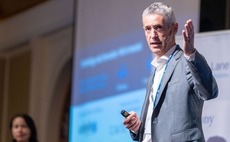
LP interview: Hermes GPE

Hermes GPE is leaning into Asia as the region proves relatively successful in deflecting COVID-19. This entails a greater focus on growth capital, country funds, and defensive sector targeting
Hermes GPE was well prepared for the pandemic. In the months prior to the COVID-19 outbreak, the UK-based fund-of-funds investor accumulated $1.6 billion of additional dry powder and began to channel the benefits of a newly finalized merger by its corporate parent.
In February, Hermes Investment Management had fully consolidated with US-based Federated Investors, forming Federated Hermes, a New York-listed multi-strategy manager with $629 billion under management and 1,900 employees across more than 20 subsidiaries globally.
Over the ensuing months, Hermes GPE, the only private equity outfit in the organization, began exploring its new potential for cross-function synergies and tracked a disproportionate hike in Asian activity.
Deal flow in the region has grown 40% year on year in 2020 and the firm's Singapore-based team of four investment professionals is now looking to increase its headcount to accommodate further growth. There have been exits from four co-investment in the region this year, each of which generated a more than 2x return.
"The COVID-19 period has been quite a fortunate time for us in terms of testing resilience in business models and the execution capacity of GPs," says Sean Yoo, Hermes GPE's head of Asia investment.
"If you look at markets like China, Korea and Taiwan, they were first-in and first-out in terms of being impacted by COVID-19, and they've been the first ones to contain the situation very well. There are some industries that have been resilient and growing in those countries as a result of that, and we're seeing more interesting deal flow there."
Small is beautiful
Hermes GPE claims around $6 billion in assets under management, of which two-thirds is in co-investments and one-third in fund commitments. Historically, allocations to funds have been 80% Western markets and 20% Asia, but that ratio has evened slightly in 2020 as Europe and the US continue to struggle to contain COVID-19.
This has helped accelerate a shift toward a more Asian-style approach to private equity as a traditionally strong focus on global, brand-name GPs gradually gives way to more growth capital and country-specific investors. Portfolio GPs include China's CITIC Capital, Korea's VIG Partners, and Australia's Pacific Equity Partners. Check sizes are $10-30 million for fund commitments and co-investments, while the core geographies are China, Southeast Asia, Korea, and Australia.
"Smaller GPs with fewer LPs are an opportunity for us to build more intimate relationships and work together as partners in co-investment deal structuring, diligence, and execution," Yoo says. "One thing we've learned is that the larger GPs do not necessarily generate better returns. The smaller country-focused GPs that we have been backing in Asia have sometimes had superior returns to some of the largest GPs in the world."
Still, Hermes GPE has taken a more conservative tack during COVID-19, even in relatively resilient Asia, and perhaps most visibly on the co-investment side. There is a sharper focus on cash flow-positive businesses with lower leverage and debt; heavily leveraged buyouts were previously the predominant approach. There is also a preference for brick-and-mortar companies with a digital overlay. Pure technology plays are considered too unpredictable.
Meanwhile, diligence in the current environment has had to get creative, with the firm sometimes settling for on-site video recordings or Zoom streams inside facilities to get an up-close look at an asset. Caution is maintained in part by restricting co-investment to GP relationships of at least 2-3 years. About 3-4 targets are sourced this way a year, of which 2-3 go on to receive investment.
"Working with a GP together on a co-investment is a really good way to understand how they source deals, how they assess risks and returns, and how they produce their internal diligence materials," Yoo says, noting how the process supports due diligence on fund commitments. "It gives us a much clearer picture of how they operate and their deal capability from sourcing, execution, and realization."
The main engine for this activity is a club formed with British Telecom Pension Scheme (BTPS) in 2013, which has gone on to include 10 members such as State Teachers Retirement System of Ohio, Canada Pension Plan Investment Board, Hostplus, Ardian, Korea Teachers Credit Union, and Korea's SeAH Group.
Three funds have been raised under this strategy, with BTPS acting as anchor LP. The UK pension plan contributed $1 billion to the latest $1.6 billion mandate, which includes a club co-investment fund of around $600 million and a separate $1 billion to be split equally between co-investments and funds.
"The club not only lets us put together capital to form a blind pool fund, but it also lets us share knowledge and deal flow with members that have an active primary program in the market," Yoo says. "It's almost like a sharing economy – multiplying relationships by the number of club members, 10 for our club, and creating a network effect."
Prevailing trends
This structure aligns neatly with the global and democratic flavor of Hermes GPE's thematic investment lens, which convenes the US, UK and Singapore offices every six months for an all-hands brainstorm about opportunities in the macro currents of the day. The virtual sessions bring together everyone from the most junior professionals, analysts and interns to regional heads and CIO Peter Gale.
Some of the latest conclusions have suggested a shift away from "globalization and outsourcing," a megatrend previously considered an area of interest but now under pressure from pandemic border closures and a toxic geopolitical backdrop.
Healthcare, by contrast, has become more attractive, as have parallel niches such as funeral services, where Hermes GPE previously scored a successful exit with Malaysia's Nirvana Asia and sees new opportunities in Korea. It's worth noting that VIG has made two acquisitions in this space, including Jo-Un Life and Preedlife, the local category leader.
"In some Asian economies, including Korea, the biggest problem they're facing in society and demographics is aging, so we've targeted businesses like funeral services with secular growth," Yoo says. "From a consumer standpoint, we like businesses that are price inelastic, and this is an area that is less price-sensitive because based on the Confucianism and cultural background in places like Korea, you would not want to send off your ancestors in a frugal manner."
Latest News
Asian GPs slow implementation of ESG policies - survey
Asia-based private equity firms are assigning more dedicated resources to environment, social, and governance (ESG) programmes, but policy changes have slowed in the past 12 months, in part due to concerns raised internally and by LPs, according to a...
Singapore fintech start-up LXA gets $10m seed round
New Enterprise Associates (NEA) has led a USD 10m seed round for Singapore’s LXA, a financial technology start-up launched by a former Asia senior executive at The Blackstone Group.
India's InCred announces $60m round, claims unicorn status
Indian non-bank lender InCred Financial Services said it has received INR 5bn (USD 60m) at a valuation of at least USD 1bn from unnamed investors including “a global private equity fund.”
Insight leads $50m round for Australia's Roller
Insight Partners has led a USD 50m round for Australia’s Roller, a venue management software provider specializing in family fun parks.








